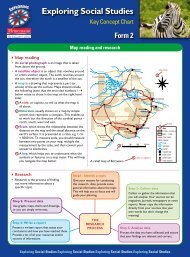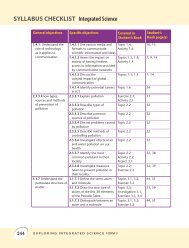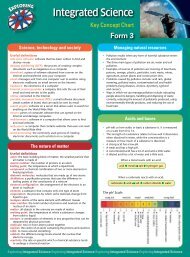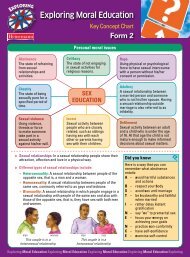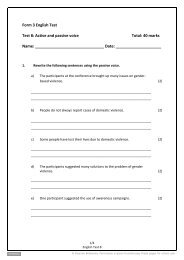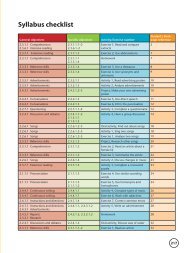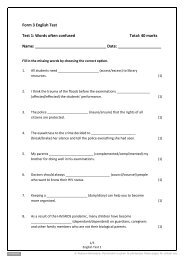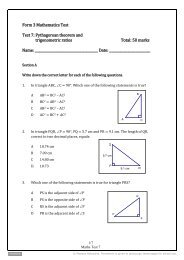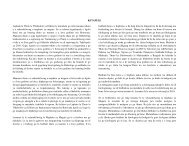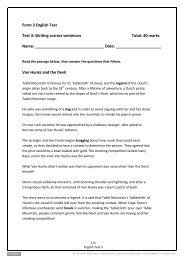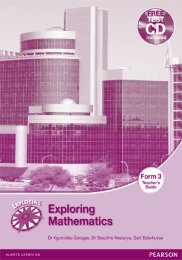Key Concept Chart - Pearson
Key Concept Chart - Pearson
Key Concept Chart - Pearson
- No tags were found...
You also want an ePaper? Increase the reach of your titles
YUMPU automatically turns print PDFs into web optimized ePapers that Google loves.
This course is supported by the onlineA NEW teaching experience!For new curriculum implementation in BotswanaHeinemann Exploring English Form 2 covers all the requirements of the Revised JuniorSecondary School English syllabus for Form 2.Exploring English Form 2 helps students to understand the subject:• Each chapter lists the learning objectives helping students to clearly understand whatthey need to be able to do• The wide range of varied activities and additional information enables studentsto explore the content• Clear and concise language makes the content accessible for students• A comprehensive glossary defines and explains new and difficult words.Exploring English Form 2 helps students to pass the subject:• Exercises help students test their understanding of the subject and build confidence• Chapter summaries reinforce learning• Revision exercises expose students to a variety of commonly used examination questions• A sample examination paper provides valuable exam practice.Exploring, a new teaching and learning experience!Heinemann books are printed on qualitypaper, and have sturdy, long-lasting covers.Brigid Conteh, Matlhoatsie Masendu, Deborah SanotoPronounsPronouns are confusing to many people!• Subject pronouns are easy, e.g.I am short.We/You are short.He/she/it is short.• Object pronouns are as follows:Give the ball to me/you/him/her/us.Here are some of the common pronoun mistakes, e.g.Can my brother and me go to the library? XCan my brother and I go to the library? ✓The teacher wants to see you and I. XThe teacher wants to see you and me. ✓He and her are prefects at school. XHe and she are prefects at school. ✓• Possessive pronouns show that something belongs tothe person or thing, e.g.That bicycle is mine. Is this your bicycle? Is this yours?Each candidate must write his/her name on the paper.• Other possessive pronouns are my, our, ours, hers, its, theirand theirs. Look out for these mistakes, both in yourwriting and as examination questions.The dog ate it’s food. (should be its)Here is you’re coffee. (should be your)Reading comprehension• Context: Before you read the text, try to work outwhere it comes from. Is it a magazine article, a newspaperreport, an extract from a textbook, etc? This will help youunderstand the text.• Skim: Read the text very quickly, casting your eye over theheadings, sub-headings, illustrations and captions. This willhelp you work out what the text is about.• Identify the question type:1. Multiple-choice questions ask you to choose the bestanswer. Be careful: sometimes there is one option that isalmost right, but another that is better.2. True/false questions ask you to agree or disagree with astatement. Often you are asked to provide evidence or toquote from the text to support your choice.3. Quotes: when you are asked to quote, use quotation marks!4. Analytical questions: these are the more difficultquestions that ask you to give your opinion, to commenton the writing style or on the author’s point of view.5. Questions about an advertisement will ask youto explain how words are used to sell a product oridea. Adjectives and adverbs can be persuasive. Someadvertisements use exaggeration, such as promising thatyou will look more attractive if you use a product.6. Read the marks: use the mark allocation as a guide asto how much to write. If a question is worth 1 mark,then don’t write five lines in your answer!Likewise, write more if a question Exploring isEnglishworth more.Contact details<strong>Pearson</strong> Botswana: Tel: +267 3922969 Fax: +267 3922682Plot 14386, New Lobatse Road, G-West Industrial Site,Gaborone, Botswana. Website: www.longmanafrica.co.zaForm 2Student’sBookExploring English Form 2 Student’s BookExploringEnglishForm 2Student’sBookFREEKEY CONCEPT CHARTWITH STUDENT’SBOOKFigures of speechUse the following to make your writing and your speechmore interesting.• Idioms are well known phrases or sayings, e.g.The corruption is just the tip of the iceberg, there is a lot moreto be uncovered.• Metaphors are comparisons, e.g.You are an angel to help me so much.• Similes: similes are very similar to metaphors. They usethe words like or as in the comparison, e.g.Her eyes are as cold as ice.• Imagery is to draw a picture of something by using words.Note: metaphors and similes are types of images!I have a ton of homework to do!When I finish school, I will be starting my journey on the riverof life.Writing papers◗ Short pieces include letters, reports, dialogues orinterviews, speeches, emails and curriculum vitaes. You mighteven be asked to design an advert.• Layout for letters: remember that the address and datego on the right, and the opening goes below that, on theleft. Formal letters end with Yours faithfully followed by yourname. Informal letters can be ended with Yours sincerely orthe even more informal Best wishes or All the best. Formalletters have an underlined subject line such as “Application foremployment” or “Order of books”.• Layout of a curriculum vitae (CV): use lots of sub-headingsto make your CV look very clear. Give your personal detailsfirst, such as age and address. Then have sub-headings such asEducation qualifications, Work experience and References.• Instructions and directions are another type of short writingtext. Here you use imperatives, such as Turn left at the street.Keep your sentences short, and make sure the order is clear.◗ EssaysThere are different types of essays:1. Creative essays, which include narratives or stories anddescriptions. Typical topics are Describe an event that changedyour life or A rainstorm.2. Factual essays, which ask you to explain information on atopic, such as Choose any Botswana tradition and explain it.3. Argumentative essays, where you might be asked todiscuss more than one opinion, or you could be asked toargue strongly in favour of one opinion. For example, youcould be asked to explain the advantages and disadvantages ofcell phones. Or you could get a topic like this: Should the legalage for drinking alcohol be increased to 21? Explain your opinion.What examiners like:1. Write a strong introduction and a strong conclusion asthese leave a good impression on the examiner.2. Make sure that the body of your essay is divided intoparagraphs that have a clear topic sentence.3. Edit your work for mistakes, so that your final draft is asgood as possible.





